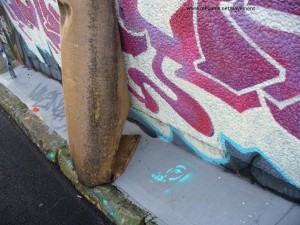Traffic marks occur frequently in Jeffrey Smart’s precisionist pictures of the built landscape, their sharp outlines and piercing colours marshalling into order the compositions of tarmacs, car-parks and autobahns that he was driven to paint. In his work, wrote Mark Ledbury, we see a celebration of the road marking as a painterly object.
With his depictions of hard-edged and perfect roads signs on even and unblemished asphalt, Smart drew our attention to a property of the pavement that we might overlook if we only concentrated on the flaws in its pocked, patched and scarred surface. For the fact is that, prosaically functional though the pavement may be, it is an edifice of monumental proportions, stretching horizontally further than the eye can see and intruding on our everyday lives in ways that we barely acknowledge.
In an interview with journalist Janet Hawley, Smart once said that he was happy if the public was stimulated by his work, ‘and if they see Jeffrey Smart paintings everywhere in the urban landscape, it means I’ve helped educate their eyes, so I’ve done them a favour’.
Thank you, Jeffrey Smart.
Ledbury, Mark. 2011. Mute eloquence: the art of Jeffrey Smart. Sydney University Museum News (25): 12-14.
Hawley, Janet. 1989. Jeffrey Smart made simple. The Sydney Morning Herald (Good Weekend), 13 May 1989, 14-20.
© Megan Hicks 2013









